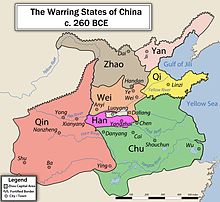Seven Warring States

The Seven Warring States or Seven Kingdoms (simplified Chinese: 战国七雄; traditional Chinese: 戰國七雄; pinyin: zhàn guó qī xióng) refers to the seven leading states during the Warring States period (c. 475 to 221 BCE) of ancient China:
Over the Warring States period, many of the seven states underwent bureaucratic and military reforms in order to mobilise resources on a greater scale. This led to an intensification of warfare over the period, but also led to economic and cultural developments on a large scale.[citation needed]
Of the Seven Warring States, Qin eventually grew to be the strongest and successfully annexed the other six states; Han was the first to fall, in 230 BCE, while Qi was the last to surrender in 221 BCE. Zheng, the King of Qin, created the new title of huangdi (emperor), and became China's first emperor, Qin Shi Huangdi.
Formation
The formation of the Seven Warring States was the culmination of trends during the preceding Spring and Autumn period, when the patchwork of states created by the Western Zhou dynasty were conquered and absorbed through warfare, coalescing into seven larger polities. Qin, Qi, Chu and Yan already existed as states during that period; Qin and Yan, owing to their remote locations, were traditionally considered second-tier powers, while Chu and Qi were among the dominant states of the period, in direct competition with the State of Jin. In 403 BCE, King Weilie of Zhou recognized Jin's partition, leading to the creation of three new states: Wei, Zhao and Han. Other major states included Wu and Yue, with the latter conquering the former in 473 BCE.
Minor Chinese and sinicized states and polities continued to exist well into the Warring States Era, such as Shu (annexed by Qin in 316 BCE), Zhongshan (annexed by Zhao in 296 BCE), Song (annexed by Qi in 286 BCE), Lu (annexed by Chu in 256 or 249 BCE).
These political changes led to changes amongst the ruling families as well: in 481 BCE, the Tian clan usurped the state of Qi in a coup and replaced the ruling Jiang clan. Meanwhile, the state of Jin, which had been controlled by different noble clans for decades, was partitioned between the Han, Zhao and Wei clans in 403 BCE.
See also
- Five Hegemons (Spring and Autumn period)
